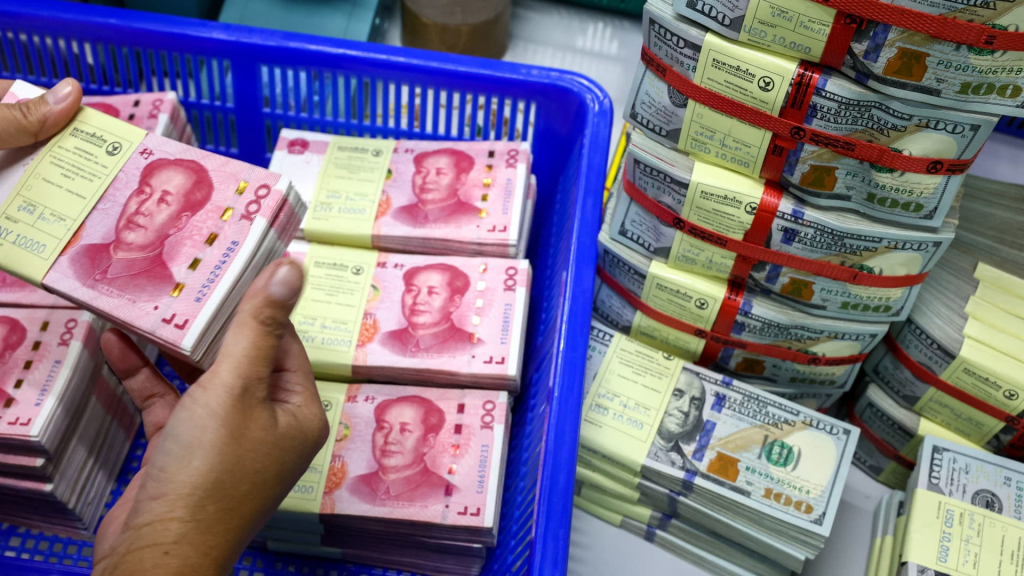China is actively exploring new options for foreign entities to utilize the yuan as global trust in the U.S. dollar wanes.
This strategy aims to position the yuan as a competitor to the dollar, according to analysts, even as the dollar continues to dominate the global currency landscape. The current context is notably advantageous, with the U.S. dollar index experiencing a decline of over 9% this year, while the offshore yuan has appreciated by more than 2% against the dollar.
During a significant address at the Lujiazui Forum last week, Pan Gongsheng, Governor of the People’s Bank of China, emphasized the need to “weaken excessive reliance on a single sovereign currency,” signaling a robust commitment from Beijing to shift the global monetary balance.
He outlined plans to establish a center for the internationalization of the digital yuan in Shanghai, in addition to promoting the trading of yuan-denominated foreign exchange futures. The Chinese government has already introduced a digital currency aimed at supplementing traditional cash and coins in circulation.
Much of China’s recent initiatives are focused on the futures market.
Starting last week, three major Chinese exchanges announced that qualified foreign institutional investors would have access to trade an additional 16 futures and options contracts listed in mainland China.
The commodities involved include natural rubber, lead, and tin, based on announcements from the Shanghai, Dalian, and Zhengzhou exchanges.
Earlier this year, numerous other futures contracts were made available to foreign institutional investors, according to Zhou Ji, a macro foreign exchange innovation analyst at Nanhua Futures, a brokerage in Hangzhou that specializes in futures markets.
Zhou noted that expanding the array of hedging products available to international institutions not only enhances the yuan’s presence but also its influence over global commodity pricing.
In a further step to encourage the adoption of the yuan among global investors, the Shanghai Futures Exchange announced in late May that it was seeking input on a proposal to allow foreign currencies as collateral for transactions settled in yuan.
Additionally, a series of incremental measures include the authorization for qualified foreign investors to engage in exchange-traded fund options trading starting October 9 for hedging purposes. Earlier this year, authorities also reportedly introduced a 500-yuan fee exemption for international financial institutions opening local accounts to access the bond market.
In January, Morgan Stanley announced that its local subsidiary was authorized to provide brokerage services for mainland China’s commodity futures, with plans to expand into equity and fixed-income offerings once they receive the appropriate qualifications.
This progress has been in the pipeline for several years; Morgan Stanley received approval from China in May 2023 to establish a wholly owned brokerage in the country.
Despite significant interest from global financial institutions in diversifying into China, the nation’s strict regulations on capital outflows and its relatively opaque financial system have impeded widespread investment in mainland Chinese assets.
Concerns persist regarding the stability of U.S. policies in recent months, yet China has not yet positioned itself as a reliable alternative for international investments, according to Matt Gertken, chief geopolitical strategist at BCA Research.
“China’s adherence to the rule of law is inferior to that of the U.S., and it lacks a vast and liquid asset pool open to foreign investors, unlike the U.S.,” he stated, adding that significant geopolitical risks related to Chinese markets remain unaddressed by Beijing.
Global payments
China’s ambitions extend beyond investment products, as the country has established a comprehensive network of offshore yuan clearing banks and is promoting a cross-border interbank payment system.
Chinese banks have increasingly opted to lend to emerging market economies in yuan rather than U.S. dollars, a shift attributed partly to lower borrowing costs, according to recent findings from the U.S. Federal Reserve.
The world’s second-largest economy has been advancing bilateral trade settlements in yuan and announced a $100 billion provision in February for businesses in Hong Kong to obtain yuan-denominated financing.
Dan Wang, director of Eurasia Group’s China team, remarked, “China seems to be accelerating its de-dollarization efforts; however, progress appears to be uneven.” She noted a rise in yuan-denominated cross-border payment settlements among energy and commodity firms in China and abroad.
Another factor contributing to the yuan’s internationalization is the overseas expansion of Chinese companies, especially smaller entities that market goods online.
Startup FundPark reported that having financial partners such as Goldman Sachs and HSBC allows China-based customers to utilize offshore yuan for operations both domestically and internationally.
Chinese authorities also subsidize some interest costs for loans issued in offshore yuan, according to Bear Huo, FundPark’s general manager in China. He mentioned that while the currency’s overall usage remains low, it is experiencing growth, though specific statistics were not disclosed.
On a global scale, the use of the Chinese yuan saw a decline in May, according to data from Swift’s RMB Tracker. The currency represented 2.89% of global payments by value, slipping to the sixth position from fifth in the previous month.
In contrast, the U.S. dollar claimed 48.46% of global payments, followed by the euro at 23.56%, as reported by Swift.
De-dollarization
The recent initiatives from Beijing to bolster the yuan align with a broader shift in Asia away from the dollar. The region is gradually lessening its dependency on the U.S. currency, influenced by geopolitical tensions, evolving monetary policies, and a rise in currency hedging practices.
Policy uncertainties during President Donald Trump’s administration have sparked notable declines in the dollar, particularly its steepest drop observed in April.
Investors seeking to diversify from U.S. assets and hedge against potential risks are increasingly turning towards the yuan, as noted by Ning Sun, a senior emerging markets strategist at State Street Global.
“Our proprietary data shows strong inflows into CNY, which is not surprising given the solid performance of CNY financial assets. Our data focuses solely on institutional investors, who remain significantly underweight in CNY,” Ning Sun added.


























